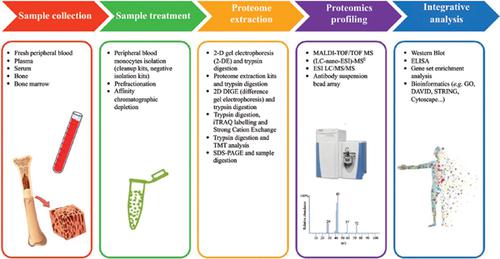Protein & Peptide Letters ( IF 1.6 ) Pub Date : 2020-11-30 , DOI: 10.2174/1871530320666200425204634 Teresa Porcelli 1 , Letizia Pezzaioli 2 , Andrea Delbarba 3 , Filippo Maffezzoni 3 , Carlo Cappelli 2 , Alberto Ferlin 2

|
Osteoporosis is a systemic skeletal disease characterized by low bone mass and microarchitectural deterioration of bone tissue. Biomarkers of bone turnover have been used for years in bone disease management, especially to determine response to treatment. They are substances found in biological fluids, produced during the bone remodelling process. Recently, new approaches for the detection of bone physiology and pathology biomarkers have been proposed, among which proteomics, with particular interest in osteoporosis. The objective of this manuscript is to review current knowledge on proteomics applied to osteoporosis in vivo. The analysis of the 14 studies published to date showed a range of proteins whose expression is altered in patients with osteoporosis. The relatively small number of papers depends mainly on high costs and technical limitations; due to the difficulty to collect osteoclasts, most of the studies performed proteomics on peripheral blood monocytes (PBMs), already accepted as an excellent osteoporosis cell model in vivo. Among the identified proteins, the most promising are represented by Gelsolin (GSN), Annexin A2 (ANXA2), and Prolyl 4-hydroxylase (P4HB). They have been related to bone mineral density (BMD), sometimes in apparent disagreement (some upregulated and others downregulated in patients with low BMD).
Finally, worthy of mention is the application of proteomics in the emerging field of microvesicles (MVs); they are important messengers, widely present in body fluids, and have recently emerged as novel targets for the diagnosis of multiple diseases, among which musculoskeletal diseases. In conclusion, the proteomic field is relatively novel in osteoporosis and has a considerable but theoretical potential; further investigations are needed in order to make proteome-derived markers applicable to clinical practice.
中文翻译:

骨质疏松症中的蛋白质标记。
骨质疏松症是一种系统性骨骼疾病,其特征是骨量低和骨组织的微结构退化。骨转换的生物标志物已用于骨骼疾病管理多年,尤其是用于确定对治疗的反应。它们是在骨骼重塑过程中产生的生物体液中发现的物质。最近,已经提出了用于检测骨生理学和病理学生物标志物的新方法,其中蛋白质组学对骨质疏松症特别感兴趣。该手稿的目的是回顾有关蛋白质组学在体内应用于骨质疏松症的最新知识。迄今为止,对14项研究的分析表明,在骨质疏松症患者中表达范围发生改变的一系列蛋白质。论文数量相对较少,主要取决于高昂的成本和技术限制;由于难以收集破骨细胞,大多数研究对外周血单核细胞(PBM)进行了蛋白质组学研究,而外周血单核细胞已被公认为是体内优秀的骨质疏松细胞模型。在已鉴定的蛋白质中,最有前途的代表是凝溶胶蛋白(GSN),膜联蛋白A2(ANXA2)和脯氨酰4-羟化酶(P4HB)。它们与骨矿物质密度(BMD)有关,有时存在明显的分歧(在BMD低的患者中有些上调而另一些下调)。最有前途的代表是凝溶胶蛋白(GSN),膜联蛋白A2(ANXA2)和脯氨酰4-羟化酶(P4HB)。它们与骨矿物质密度(BMD)有关,有时存在明显的分歧(在BMD低的患者中有些上调而另一些下调)。最有前途的代表是凝溶胶蛋白(GSN),膜联蛋白A2(ANXA2)和脯氨酰4-羟化酶(P4HB)。它们与骨矿物质密度(BMD)有关,有时存在明显的分歧(在BMD低的患者中有些上调而另一些下调)。
最后,值得一提的是蛋白质组学在新兴的微囊泡领域中的应用。它们是重要的信使,广泛存在于体液中,并且最近已成为诊断多种疾病(包括肌肉骨骼疾病)的新靶标。总之,蛋白质组学领域在骨质疏松症中相对较新,具有相当大的理论潜力。为了使蛋白质组标记物适用于临床实践,还需要进一步的研究。



























 京公网安备 11010802027423号
京公网安备 11010802027423号